|
|
|
Sort Order |
|
|
|
Items / Page
|
|
|
|
|
|
|
| Srl | Item |
| 1 |
ID:
118846


|
|
|
|
|
| Publication |
2013.
|
| Summary/Abstract |
China's CO2 emission has attracted world's attention in the last few years for its rapid increase. It is necessary to analyze the current situation of China's carbon emission for its CO2 reduction. Carbon flow chart is an intuitive and quantitative tool for showing a whole picture of CO2 flows and emissions data. According to the IPCC method, the authors analyze China's CO2 emissions and draft China's CO2 flow chart for 2008. We find that: (1) China's CO2 emissions increase fast, while its CO2 intensity declines continuously in most years; (2) CO2 emissions from industry and construction account for 76.67% of the total CO2 emissions of terminal sub-sectors, in which ferrous metal industry emits the largest amount; (3) coal maintains as the largest emission source of CO2 from the point of view of fuel type in China, accounting for 78.20% of the total primary CO2 flow; (4) process emissions are considerable and (5) it is necessary to adjust the primary energy mix in China for energy-related CO2 reduction.
|
|
|
|
|
|
|
|
|
|
|
|
|
|
|
|
| 2 |
ID:
103460


|
|
|
|
|
| Publication |
2011.
|
| Summary/Abstract |
China is the world's second-largest energy producer and consumer, so that it is very necessary to analyze China's energy situation for saving energy consumption and reducing GHG emission. Energy flow chart is taken as a useful tool for sorting out and displaying energy statistics data. Energy statistics data is the premise and foundation for analyzing energy situation. However, there exit many differences between China and foreign energy balance. Based on the international criterion of energy balance and some advices given by related experts, the author properly adjusts China's energy balance. And the purpose of this paper is to draft China's energy flow chart for 2007, which is used to study the characteristics of energy production and consumption in China. We find that: (1) coal is the main energy in China, which accounted for 73.2% of total energy supply in 2007; (2) thermal power accounted for 83.2% of the total electricity supply, and 78.43% thermal power was based on coal; (3) in 2007, the secondary industrial sector consumed about 69.93% of energy; (4) China's energy utilization efficiency was about 33.23% in 2007.
|
|
|
|
|
|
|
|
|
|
|
|
|
|
|
|
| 3 |
ID:
110363
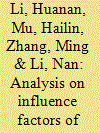

|
|
|
|
|
| Publication |
2011.
|
| Summary/Abstract |
With the intensification of global warming and continued growth in energy consumption, China is facing increasing pressure to cut its CO2 (carbon dioxide) emissions down. This paper discusses the driving forces influencing China's CO2 emissions based on Path-STIRPAT model-a method combining Path analysis with STIRPAT (stochastic impacts by regression on population, affluence and technology) model. The analysis shows that GDP per capita (A), industrial structure (IS), population (P), urbanization level (R) and technology level (T) are the main factors influencing China's CO2 emissions, which exert an influence interactively and collaboratively. The sequence of the size of factors' direct influence on China's CO2 emission is A>T>P>R>IS, while that of factors' total influence is A>R>P>T>IS. One percent increase in A, IS, P, R and T leads to 0.44, 1.58, 1.31, 1.12 and -1.09 percentage change in CO2 emission totally, where their direct contribution is 0.45, 0.07, 0.63, 0.08, 0.92, respectively. Improving T is the most important way for CO2 reduction in China.
|
|
|
|
|
|
|
|
|
|
|
|
|
|
|
|
| 4 |
ID:
090935


|
|
|
|
|
| Publication |
2009.
|
| Summary/Abstract |
The Chinese Government has stepped up its drive to reconstruct its international financial strategy after the sub-prime crisis developed into a global financial crisis in 2008. The main aim of the strategy is to reduce the country's dependence on the US dollar in foreign trade, cross-border capital flows and foreign exchange reserve management. The strategy can be divided into three tiers: renminbi internationalization, regional monetary cooperation and reconstruction of the international monetary regime. So far, the Chinese Government has fared well in the application of all three tiers. We hold that the Chinese Government should continue in the same direction in a coordinated manner despite various challenges it faces.
|
|
|
|
|
|
|
|
|
|
|
|
|
|
|
|
| 5 |
ID:
086482
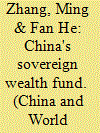

|
|
|
|
|
| Publication |
2009.
|
| Summary/Abstract |
The establishment of sovereign wealth funds in large developing countries has generated hot debate among participants in the international financial market. When accumulated foreign exchange reserves surpass a sufficient and an appropriate level, the costs, risks and impacts of holding reserves on the macroeconomy of a country need to be considered. The Chinese Government established China Investment Corporation (CIC) in 2007 to diversify its investment of foreign reserves and to raise investment income. However, because of certain conflicts of interest and institution-design caveats, CIC possesses some internal weakness, including a vague orientation, mixed investment strategies and an inefficient bureaucratic style. Although the subprime crisis has softened certain regulations and lessened rejection by the USA of CIC potential investments, the increased volatility and uncertainty of the market means that CIC is facing some new challenges in terms of its investment decisions. Moreover, CIC is competing with other Chinese investment institutions for injections of funds from the Chinese Government.
|
|
|
|
|
|
|
|
|
|
|
|
|
|
|
|
| 6 |
ID:
113007
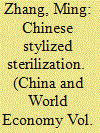

|
|
|
|
|
| Publication |
2012.
|
| Summary/Abstract |
This paper attempts to explain why sterilized intervention was so successful and sustainable in China during the first decade of the 21st century. We argue that the Chinese Government established a sterilization cost-sharing mechanism among the People's Bank of China, commercial banks and the household sector. On the one hand, Chinese commercial banks have to assume some of the sterilization costs by purchasing low yield central bank bills and maintaining high levels of required reserves. On the other hand, Chinese households assume some of the sterilization costs by bearing negative real deposit interest rates. The cost-sharing mechanism under financial repression prevents a huge quasi-fiscal loss by the People's Bank of China as well as high inflation. However, Chinese households have become victims of this financial repression. Faced with the pressure of changing the growth model from investment-driven to domestic consumption-driven, the interest rate will have to be liberalized eventually, which will, in turn, make sterilized intervention unsustainable.
|
|
|
|
|
|
|
|
|
|
|
|
|
|
|
|
| 7 |
ID:
117233
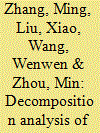

|
|
|
|
|
| Publication |
2013.
|
| Summary/Abstract |
Electricity generation in China mainly depends on coal and its products, which has led to the increase in CO2 emissions. This paper intends to analyze the current status of CO2 emissions from electricity generation in China during the period 1991-2009, and apply the logarithmic mean Divisia index (LMDI) technique to find the nature of the factors influencing the changes in CO2 emissions. The main results as follows: (1) CO2 emission from electricity generation has increased from 530.96 Mt in 1991 to 2393.02 Mt in 2009, following an annual growth rate of 8.72%. Coal products is the main fuel type for thermal power generation, which accounts for more than 90% CO2 emissions from electricity generation. (2) This paper also presents CO2 emissions factor of electricity consumption, which help calculate CO2 emission from final electricity consumption. (3) In China, the economic activity effect is the most important contributor to increase CO2 emissions from electricity generation, but the electricity generation efficiency effect plays the dominant role in decreasing CO2 emissions.
|
|
|
|
|
|
|
|
|
|
|
|
|
|
|
|
| 8 |
ID:
169158


|
|
|
|
|
| Summary/Abstract |
This paper summarizes global imbalance adjustment after the GFC and analyzes the evolution of balance of payments using a four‐quadrant diagram. We construct the framework of a stock adjustment mechanism to analyze the main driving factors for the imbalance in surplus/deficit countries and debtors/creditors in an attempt to determine the sustainability of imbalance adjustment. We find that imbalances have been reduced to some extent, but most countries have not achieved rebalance after the global financial crisis. Therefore, we propose an ideal path for global imbalance adjustment and summarize the policy practices of representative countries that have followed this route. Based on our analysis, we suggest that China should learn from the Australian experience and adopt a macro‐prudential assessment policy, actively adjust the domestic economic structure and optimize the structure of balance of payments.
|
|
|
|
|
|
|
|
|
|
|
|
|
|
|
|
| 9 |
ID:
098862
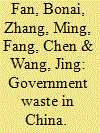

|
|
|
|
|
| Publication |
2010.
|
| Summary/Abstract |
The administrative expenditure of China has been growing rapidly in the past decades. This paper examines the forms and causes of government waste hidden in the high levels of administrative expenditure. Based on the findings, several specific policy suggestions are made.
|
|
|
|
|
|
|
|
|
|
|
|
|
|
|
|
| 10 |
ID:
006341


|
|
|
|
|
| Publication |
Boulder, Lynne Rienner, 1995.
|
| Description |
xiii, 221p., figures and tables
|
| Standard Number |
1555875939
|
|
|
|
|
|
|
|
|
|
|
|
Copies: C:1/I:0,R:0,Q:0
Circulation
| Accession# | Call# | Current Location | Status | Policy | Location |
| 037727 | 337.19/ZHA 037727 | Main | On Shelf | General | |
|
|
|
|
| 11 |
ID:
152509


|
|
|
|
|
| Summary/Abstract |
Persistent renminbi (RMB) devaluation expectations are one of the greatest threats to China's macroeconomic stability. Market interventions backed by huge foreign exchange reserves and capital controls are not sufficient to eliminate the expectations of devaluation. Creating a market-based and flexible RMB exchange rate regime holds the key to the elimination of devaluation expectations. The present paper compares the pros and cons of several policy options, and proposes to introduce, as a transition to free floating, a new exchange rate regime pegged to a currency basket with a wide band. The new regime should be able to give the RMB exchange rate enough flexibility to eliminate devaluation expectations as well as prevent excessive overshooting. To ensure a smooth transition, the new regime needs to be supported by controlling cross-border capital flows.
|
|
|
|
|
|
|
|
|
|
|
|
|
|
|
|
| 12 |
ID:
118293


|
|
|
|
|
| Publication |
Hampshire, Macmillan, 1999.
|
| Description |
IX 160p.
|
| Standard Number |
0333754751
|
|
|
|
|
|
|
|
|
|
|
|
Copies: C:1/I:0,R:0,Q:0
Circulation
| Accession# | Call# | Current Location | Status | Policy | Location |
| 041351 | 327.73051/ZHA 041351 | Main | On Shelf | General | |
|
|
|
|
| 13 |
ID:
137600


|
|
|
|
|
| Summary/Abstract |
his paper argues that the twin surpluses in China's balance of payments will disappear in the future as a result of external and internal structural changes. China's current account surplus will diminish as a result of the decline in the goods trade surplus, the expanding service trade deficit and negative investment income. China's capital account might shift from surplus to deficit as a result of shrinking net direct investment inflows and more volatile short-term capital flows. When the twin surpluses no longer exist, the normalization of the US treasury bond yields will be sped up, terminating the one-way appreciation of the RMB exchange rate; the People's Bank of China's pressure to sterilize inflows will be alleviated, and new problems for the People's Bank of China's monetary operation will emerge; new financial vulnerabilities for the Chinese economy will arise. Finally, the present paper provides some policy suggestions for the Chinese Government to deal with the declining twin surpluses.
|
|
|
|
|
|
|
|
|
|
|
|
|
|
|
|
|
|
|
|
|